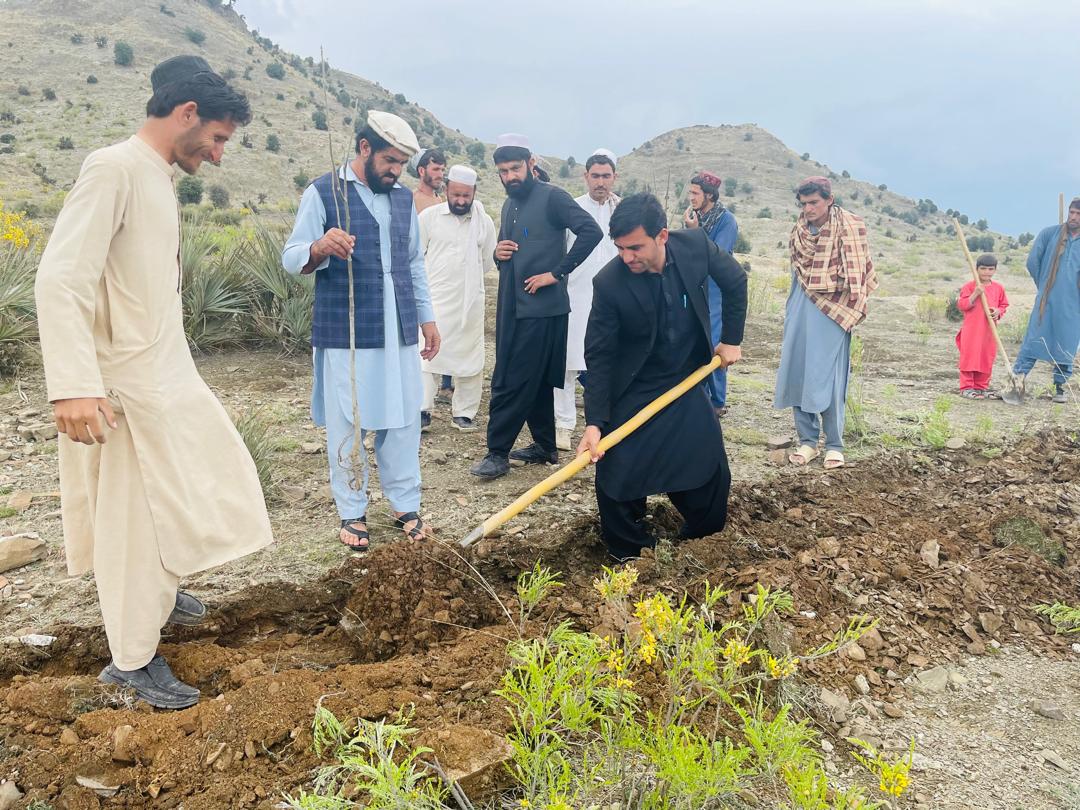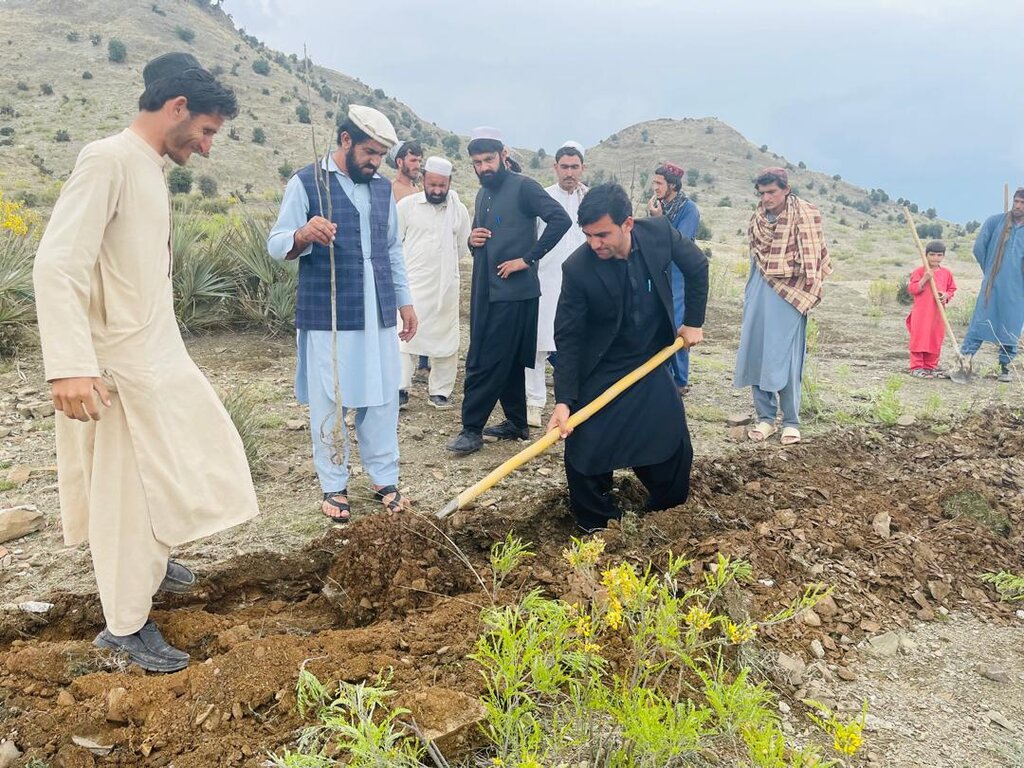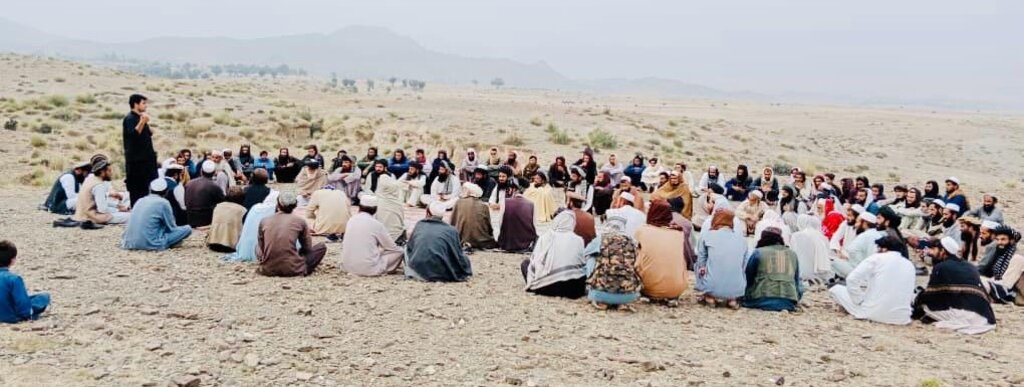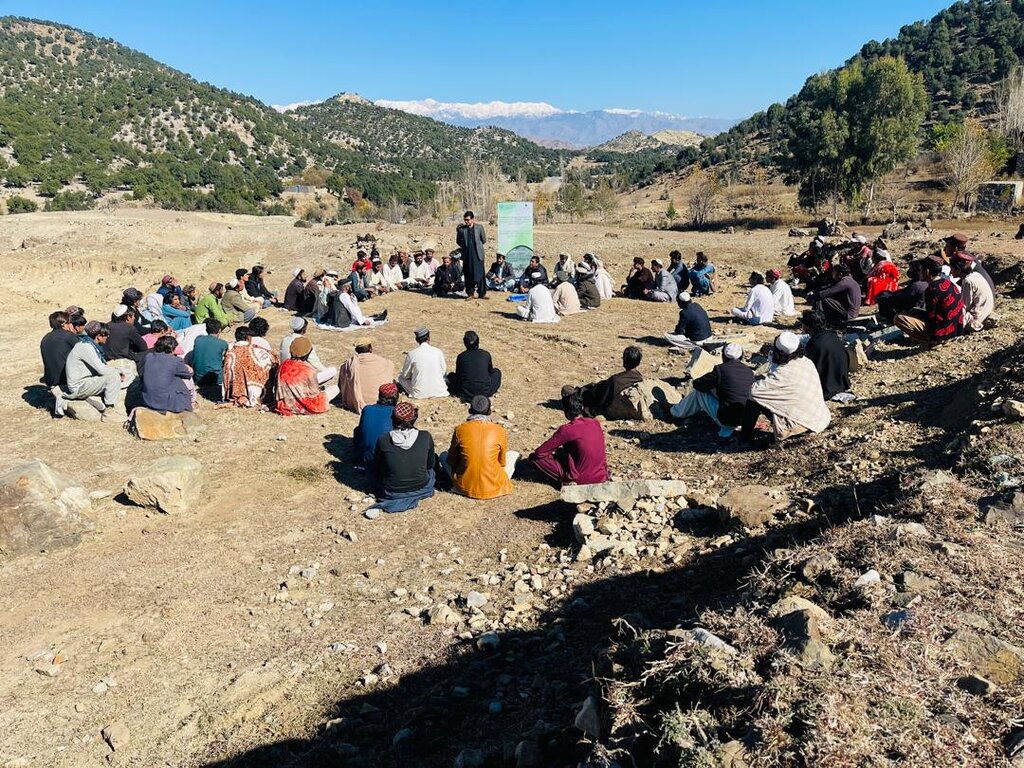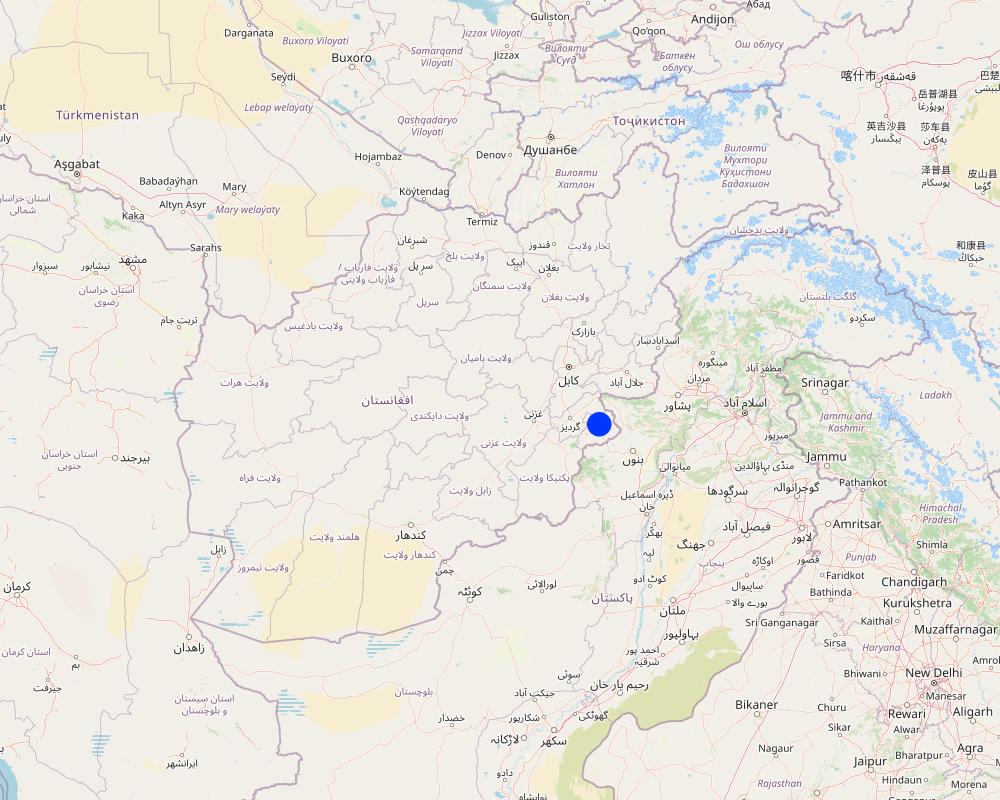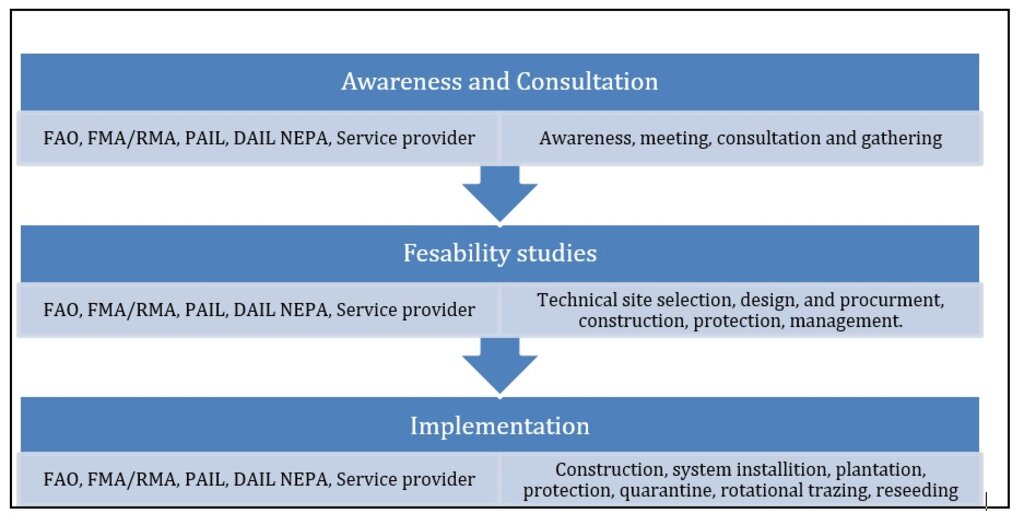Community based reforestation initiatives to restore degraded forest and rangeland [Афганистан]
- Создание:
- Обновить:
- Составитель: Mohammad Aslam Hasand
- Редакторы: Megha bajaj, Afghanistan Safi, Mohammad Arif
- Рецензенты: Rima Mekdaschi Studer, Illias Animon, Muhammad Ishaq Safi
د ټولنې پر مټ د بيا رغنيز نوښت له لارې د تخريب شوي ځنګل او څړځای رغول
approaches_7470 - Афганистан
- Полная аннотация в формате PDF
- Полная аннотация в формате PDF для вывода на печать
- Полная аннотация в формате интернет-страницы
- Полная аннотация (неотформатированно)
- Community based reforestation initiative to restore degraded forest and rangeland.: 6 марта 2025 г. (inactive)
- Community based reforestation initiative to restore degraded forest and rangeland.: 24 марта 2025 г. (inactive)
- Community based reforestation initiative to restore degraded forest and rangeland.: 2 мая 2025 г. (inactive)
- Community based reforestation initiatives to restore degraded forest and rangeland: 7 мая 2025 г. (public)
Просмотреть разделы
Развернуть все Свернуть все1. Общая информация
1.2 Контактные данные специалистов и организаций, участвующих в описании и оценке Подхода
Специалист по УЗП:
землепользователь:
Haleem Bakhtawer Khan
0765983451
bakhtawerkhan.halim@gmail.com
Sapari Forest and Rangeland Management Association
Sapari, Sabari, Khost, Afghanistan
Афганистан
Название проекта, содействовавшего документированию/оценке Подхода (если применимо)
Community-based sustainable land and forest management in AfghanistanНазвание организации (-ий), содействовавших документированию/оценке Подхода (если применимо)
FAO Afghanistan (FAO Afghanistan) - Афганистан1.3 Условия, регламентирующие использование собранных ВОКАТ данных
Когда были собраны данные (на местах)?
15/12/2024
Составитель и ответственный/-ые специалист(-ы) согласны с условиями, регламентирующими использование собранных ВОКАТ данных:
Да
2. Описание Подхода УЗП
2.1 Краткое описание Подхода
Community-driven reforestation initiative that involves awareness-raising, capacity building, feasibility analysis, and collaboration among various stakeholders to address land degradation and promote sustainable forest and rangeland management
2.2 Подробное описание Подхода
Подробное описание Подхода:
The main aim of this approach is to contribute to ecosystem restoration, biodiversity conservation and carbon sequestration through community awareness-raising, consultation and capacity building, feasibility analysis, site selection as well as resources mobilization for reforestation initiatives in Khost, Afghanistan.
This community driven initiative emerged, bringing together land users, forest and rangeland management associations, environmental experts, specialists and policymakers from various departments like Provincial Agriculture, Irrigation and Livestock, National Environment Projection Agency, District Agriculture, Irrigation and Livestock to heal the land, restore the forests, and rebuild the connection between people and nature.
The first step was to understand the root causes of degradation, followed by a detailed assessment to identify areas most in need of intervention. Priority was given to barren land stripped by erosion, degraded forests areas, and nutrient-depleted soils. The community incorporated traditional ecological knowledge shared by local elders, who recalled periods when the valley supported dense vegetation and thriving ecosystems. This was combined with modern ecological practices to develop a comprehensive restoration plan that balanced traditional knowledge with scientific innovation. The approach ensures awareness raising of the rural community, and knowledge and information enhancement on restoration of degraded forest and rangeland through reforestation initiatives in Khost, Afghanistan.
Specific objectives of the approach are:
1. To enhance the knowledge and awareness of rural communities in Khost, Afghanistan on restoring degraded forests and rangelands, including through public awareness, campaigns, community mobilization, consultations, and feasibility assessments, and mobilizing resources.
2. Involve key stakeholders actively in restoration, including Provincial Agriculture Irrigation and Livestock (PAIL), Provincial National Environmental Protection Agency (NEPA), District Agriculture Irrigation and Livestock department (DAIL), Forest and Rangeland Management Association (FM/RM Association).
3. To enhance the capacity of Forest and Rangeland Management Association (FM/RM Associations) and local communities for effective restoration of degraded forests and rangelands through reforestation initiatives in Khost, Afghanistan.
4. To restore degraded forests and rangelands by enhancing knowledge, skills, and resources for sustainable management. This includes empowering the FM/RM Associations by improving its members’ understanding, skills, capacity, and active participation in conservation and restoration efforts.
5. To restore habitat for strengthening biodiversity conservation.
2.3 Фотографии, иллюстрирующие Подход
Общие замечания к фотографиям:
Public awareness and community mobilization – engaging local communities, tribal elders, and stakeholders in decision-making, social participation as well as capacity building – training communities on sustainable practices and policy enforcement.
2.5 Страна/ регион/ место, где применялся Подход
Страна:
Афганистан
Административная единица (Район/Область):
Khost
Более точная привязка места:
Sapari forest, Sabari district, Khost, Afghanistan
Map
×2.6 Даты начала и окончания реализации Подхода
Год начала реализации:
2023
Год окончания (Если Подход больше не применяется):
2026
2.7 Тип Подхода
- в рамках проекта/ программы
2.8 Каковы цели/ задачи Подхода
To enhance the capacity of FM/RM Associations and local communities for adopting the technology on restoration of degraded forests and rangelands through reforestation initiatives in Khost.
-To restore habitat for strengthening biodiversity conservation.
-To promote the conversion of unproductive lands to productive lands.
-To empower local communities to replicate and scale up similar initiatives.
2.9 Условия содействующие применению Технологии/ Технологий в рамках Подхода или затрудняющие его
Социальные/ культурные/ религиозные нормы и ценности
- содействуют
Social gathering, social participation for sapling plantation, information sharing among community members.
Наличие/ доступность финансовых ресурсов и услуг
- содействуют
There is availability and access to financial resource and services, because all the financial support is directly transferred to community.
Институциональные условия
- содействуют
FM/RM Associations are established to improve forest and rangeland management.
Сотрудничество/ координация действий
- содействуют
Other projects are collaborating with FM/RM Associations due to their status as a legal entity
Нормативно-правовая база (землевладение, права на земле- и водопользование)
- затрудняют
The legal framework for land tenure and land and water use rights exists; they are, however, not properly implemented.
Осведомленность в области УЗП, доступность технической поддержки
- содействуют
Community members have access to SLM knowledge through awareness raising, training and workshops offered
Объем работ, доступность рабочей силы
- содействуют
Workload of FM/RM Associations during plantation campaign, protection and general management.
3. Участие и распределение ролей заинтересованных сторон
3.1 Заинтересованные стороны, участвующие в реализации Подхода и их роли
- местные землепользователи/ местные сообщества
Local community and farmers
Land users, local community members: Mobilizations, awareness, social participation as well as self-contribution.
- организации местных сообществ
Forest and Rangeland Management Associations (FM/RM Associations)
FM/RM Associations: decision making, awareness, mobilization, capacity building and social structure for self and in kind contribution.
- эксперты по УЗП/ сельскому хозяйству
FAO specialist
Technical assistance
- частный сектор
Construction company
Construction, mechanical work and installation of system in including facilitation
- местные власти
Provincial Agriculture and Livestock (PAIL), District Agriculture Irrigation and Livestock (DAIL), National Environment Protection Agency (NEPA)
Facilitation for the implementation of project
- международные организации
FAO (Food and Agriculture Organization of the United Nations)
Implementation of the GEF-funded project and technical assistance
Если участвовало несколько заинтересованных сторон, назовите ведущую организацию:
UNFAO (Food and Agriculture Organization of the United Nations)
3.2 Участие местных землепользователей/ местных сообществ на разных стадиях реализации Подхода
| Участие местных землепользователей/ местных сообществ | Перечислите участников и опишите их вовлеченность | |
|---|---|---|
| инициирование/ мотивация | самоорганизация | FM/RM Association: mobilization, awareness raising and general management through social participation. |
| планирование | интерактивное | FM/RM Association: jointly with community by developing of Community Based Natural Resources Management (CBNRM) plan. |
| выполнение | интерактивное | FM/RM Association: jointly with community provided labour, facilitation, coordination and consultation as well as supporting all the activities during implementation period as self and community in kind contribution. |
| мониторинг/ оценка | интерактивное | FM/RM Association: members are key stakeholders of the participatory monitoring and evaluation process. |
3.3 Схема реализации (если имеется)
Описание:
"The Restoration of Degraded Forest and Rangeland Approach" focuses on reviving degraded forest, rangeland and generally ecosystems through sustainable reforestation initiatives. This approach involves: Identifying degraded areas and developing restoration initiatives, involving local communities in decision-making and capacity-building, planting native species, improving soil health, and adopting sustainable land management techniques, regularly assessing progress, addressing challenges, and ensuring long-term sustainability.
This integrated approach helps restore forest and rangeland, biodiversity, improve water retention, prevent soil erosion, and enhance local livelihoods.
Acronyms and Key Concepts:
Food and Agriculture Organization of the United Nations (FAO)
Provincial Agriculture, Irrigation and Livestock (PAIL)
District Agriculture, Irrigation and Livestock (DAIL)
Forest and Rangeland Management Association (FM/RM Association)
Service providers are referred to different construction and logistics’ companies and contractors.
Автор:
Mohammad Aslam Hasand
3.4 Принятие решений по выбору Технологии/ Технологий УЗП
Укажите, кто принимал решение по выбору применяемой Технологии/ Технологий:
- все участники как часть процесса совместных действий
Поясните:
It was a participatory feasibility study that involved joint decision making
Поясните на чём было основано принятие решений:
- анализ подробно описанного опыта и знаний по УЗП (принятие решений на основе подтвержденных фактов)
4. Техническая поддержка, повышение компетенций и управление знаниями
4.1 Повышение компетенций/ обучение
Проводилось ли обучение землепользователей/ других заинтересованных лиц?
Да
Укажите, кто проходил обучение:
- землепользователи
- местный персонал/консультанты
Тип обучения:
- в ходе работы
- обмен опытом между фермерами
- общие собрания
Рассматриваемые темы:
SLM/SFM practices, awareness, mobilization, quarantine, rotational grazing, biodiversity conservation, climate change, CBNRM plan, participatory moinotoring, operation of the system and general management of natural resources.
4.2 Консультационные услуги
Есть ли у землепользователей возможность получать консультации?
Да
Укажите, где именно оказываются консультационные услуги:
- на полях землепользователей
Описание/ комментарий:
Operating the irrigation system, sapling transplantation, quarantine, rotational grazing and general management.
4.3 Институциональная (организационная) поддержка
В ходе реализации Подхода были ли организованы новые институциональные структуры или поддержаны уже существующие?
- да, умеренно
Укажите уровень, на котором структуры были укреплены или вновь созданы:
- местные
Опишите организацию, функции и ответственность, членство и т.д.
FM/RM Association
Укажите тип поддержки:
- финансовая
- повышение компетенций/ обучение
- оборудование
Подробнее:
Signed LoA for implementation and cost contribution, on site awareness raising, social mobilization, holding gathering and workshops and provided construction materials and tools for nursery establishment.
4.4 Мониторинг и оценка
Являются ли мониторинг и оценка частью Подхода?
Да
Комментарии:
FM/RM Association has the responsibility to perform monitoring of all activities in Sapari forest of Sabari district of Khost province.
Если да, будет ли данный документ использоваться для мониторинга и оценки?
Да
Комментарии:
Monitoring is a part of the Community-based NRM plan.
4.5 Научные исследования
Были ли научные исследования частью Подхода?
Нет
5. Финансирование и внешняя материальная поддержка
5.1 Годовой бюджет мероприятий по УЗП в рамках Подхода
Если точный годовой бюжет неизвестен, укажите примерный диапазон затрат:
- 10000-100000
Комментарий (например, основные источники финансирования/ ключевые доноры):
Financial support is provided by the FAO-GEF project and in-kind contributions are from the community. In-kind contribution covers providing physical space or facilities to support the project, coordination, consultation and general facilitation, and human resources for restoration, patrolling, quarantine, and other community relevant activities. Hence, 80 percent of the financial support is provided by the FAO-GEF project and 20 percent by the community (as in-kind support).
5.2 Финансирование и внешняя материальная поддержка, предоставляемая землепользователям
Предоставлялась ли землепользователям финансовая/ материальная поддержка для применения Технологии /Технологий?
Да
Если да, укажите тип(-ы) поддержки, кто ее предоставил и условия предоставления:
Technical support and livelihood packages including solar cooker, chopper machine, dairy toolkit, walnut cracker, construction material for reservoirs (cement, sand, stone, pipes), material for nursery establishment and saplings were provided.
5.3 Субсидии на отдельные затраты (включая оплату труда)
- нет
Если труд землепользователя был существенным вкладом, укажите, был ли этот вклад:
- добровольный
5.4 Кредитование
Предоставлялись ли в рамках Подхода кредиты на мероприятия УЗП?
Нет
5.5 Другие методы или инструменты стимулирования
Использовались ли другие методы или инструменты стимулирования для продвижения Технологий УЗП?
Да
Если да, поясните:
Training workshops and other capacity building programmes, field day tour, social gathering as well as site visits by communities.
6. Анализ влияния и заключительные положения
6.1 Влияние Подхода
Сумел ли Подход расширить возможности местных землепользователей, повысить участие заинтересованных сторон?
- Нет
- Да, немного
- Да, умеренно
- Да, существенно
Capacity building, empowering of Forest and rangeland management associations (FM/RM Associations)
Сумел ли Подход дать возможность принимать решения на основе подтвержденных фактов?
- Нет
- Да, немного
- Да, умеренно
- Да, существенно
Monitoring and participatory assessment skills were improved under the approach allowing to assess results and impacts and collecting evidence for decision-making
Сумел ли Подход помочь землепользователям внедрить и поддерживать технологии УЗП?
- Нет
- Да, немного
- Да, умеренно
- Да, существенно
Consultation meetings, workshops, training, on job practical work and capacity building for better implementation of the technology.
Сумел ли Подход улучшить согласованность действий и повысить рентабельность применения практик УЗП:
- Нет
- Да, немного
- Да, умеренно
- Да, существенно
FM/RM Associations and local community contribution, particularly providing of labour during plantation campaigns, protection and maintenance.
Сумел ли Подход мобилизовать/ расширить доступ к финансовым ресурсам для применения практик УЗП?
- Нет
- Да, немного
- Да, умеренно
- Да, существенно
Financial resources accessed according to the terms specified in the LoA.
Сумел ли Подход расширить знания и возможности землепользователей в применении практик УЗП?
- Нет
- Да, немного
- Да, умеренно
- Да, существенно
FAO technical staff conducted various trainings, workshop as well as awareness raising session regarding improving of land users’ capacity for better implementation of the SLM.
Сумел ли Подход расширить знания и возможности других заинтересованных сторон?
- Нет
- Да, немного
- Да, умеренно
- Да, существенно
Local governmental institutions like provicial and district Agriculture, Irrigation and Livestock (PAIL/DAIL) departements,FM/RM Associations and local community knowledge has been improved on SLM/SFM.
Сумел ли Подход укрепить сотрудничество между заинтересоваными сторонами/ выстроить механизмы сотрудничества?
- Нет
- Да, немного
- Да, умеренно
- Да, существенно
Collaboration among FM/RM Associations, local community, governmental institutions and other stakeholders has been strengthened.
Сумел ли Подход снизить остроту конфликтов?
- Нет
- Да, немного
- Да, умеренно
- Да, существенно
FM/RM Associations and local community facilitated implementation of the project on communal land as well as mitigated all sort of conflicts regarding protection, quarantine, rotational grazing and other sections.
Сумел ли Подход содействать гендерному равенству и расширить права и возможности женщин и девочек?
- Нет
- Да, немного
- Да, умеренно
- Да, существенно
Women were actively involved in all project activities; some livelihood programs have been targeted at women and girls.
Сумел ли Подход стимулировать молодежь/ будущее поколение землепользователей заниматься УЗП?
- Нет
- Да, немного
- Да, умеренно
- Да, существенно
Through awareness raising, workshop, training, farmer field schools, brochures and other visibility materials encouraged young people or next generation to engage in SLM.
Awareness raising sessions, trainings and workshops enhanced the knowledge of Forest and Rangeland Management Association (FMA/RMA) members and local community regarding sustainable of natural resource management.
Сумел ли Подход улучшить способность землепользователей адаптироваться к изменениям климата и смягчать последствия катастрофических погодных явлений?
- Нет
- Да, немного
- Да, умеренно
- Да, существенно
Improved water harvesting, controlled land degradation, planted saplings, prevented flood splash and water erosion which improved land users’ resilience to climatic changes/extremes and disaster.
Сумел ли Подход привести к созданию новых рабочих мест/ к расширению возможностей получения дохода?
- Нет
- Да, немного
- Да, умеренно
- Да, существенно
Short employment created for local community.
6.2 Основные причины, побуждающие землепользователей внедрять УЗП
- рост продуктивности
Increased production of fodder from trees and grasses.
- снижение деградации земель
Improved soil cover reduces water-induced erosion, helping to preserve soil fertility. Water harvesting captures surface runoff for irrigation and contributes to groundwater recharge.
- снижение риска катастрофических погодных явлений
- снижение объёма работ
Through active social participation.
- нормативно-правовое регулирование (штрафы)/ контроль
Enforcement of customary roles and regulations among the community, enhance tribal and traditional structures for facilitation and implementation of the technology.
- приобретение знаний и опыта в области УЗП
The consciousness of local community has been enhanced regarding SLM.
- снижение остроты конфликтов
The establishment of FM/RM Associations helped mitigate conflicts and facilitated smoother project implementation.
6.3 Долгосрочная устойчивость мероприятий в рамках Подхода
Могут ли землепользователи самостоятельно (без внешней поддержки) продолжать применение того, что было реализовано в рамках Подхода?
- да
Если да, опишите как:
Land users can sustain these efforts because their capacity has been strengthened, they have a sense of local ownership, and adaptive tribal management systems are in place, ensuring the long-term benefits of restoration for future generations.
6.4 Сильные стороны/ преимущества Подхода
| Сильные стороны/ преимущества/ возможности по мнению землепользователей |
|---|
| Awareness, consciousness and knowledge on natural resources management of communities enhanced through workshops and trainings. |
| Increased availability of natural resources for better livelihoods of communities. |
| With increased community contribution, local efforts will support the protection and sustainable management of resources even after external support ends. |
| Сильные стороны/ преимущества/ возможности по мнению составителя или других ключевых специалистов |
|---|
| This approach revives ecosystems by reintroducing native plant and animal species, supporting increased biodiversity and creating habitats for wildlife. |
| This approach improves ecosystem resilience, supports sustainable livelihoods, and promotes climate change adaptation. Restoration ensures long-term sustainability while addressing environmental, economic, and cultural needs. |
| The established FM/RM Associations have become the recognized legal bodies for managing forests, rangelands, and other natural resources. They will be responsible for ensuring sustainability and long-term protection after the project. |
6.5 Слабые стороны/ недостатки Подхода и пути их преодоления
| Слабые стороны/ недостатки/ риски по мнению землепользователей | Возможные пути их преодоления/снижения? |
|---|---|
| FM/RM Associations established, but they need to be better organized and recognized. | The Ministry of Agriculture Irrigation and Livestock of Afghanistan may connect and empower these local institutions. |
| Some components of the project were intended for women’s participation; however, due to government restrictions on women's employment, this remains a sensitive issue and can be considered a limitation in project implementation. | Government should consider mainstreaming gender in such projects where gender is a key aspect. |
| This approach has been implemented in faraway forests with little management personnel to enforce law on the ground; unless communities manage these lands well, protection of natural resources could get weak. | Community should take more responsibility for protecting natural resources. |
| Слабые стороны/ недостатки/ риски по мнению составителя или ответственных специалистов | Возможные пути их преодоления/снижения? |
|---|---|
| This approach often requires significant initial investment in terms of funding, materials, labor, and technical expertise. This includes costs for site preparation, planting, irrigation, and ongoing maintenance, which can be limiting for many communities. | Adequate budget and community contribution can overcome or reduce this weakness. |
| This approach can take many years, even decades, to show significant ecological improvements, which can lead to frustration, reduced enthusiasm, or a loss of community and donor support. | Strong mobilization and raising of the ownership sense in the community can overcome this weakness. |
| If local communities are not adequately involved, they may not feel a sense of ownership or responsibility for the project, leading to poor long-term maintenance and protection of the restored areas. | This should be a community-based project, ensuring that, after donor support ends, the community takes responsibility for its ongoing maintenance and sustainability. |
| Insecure land tenure and unclear property rights can lead to conflicts over land use and limit the ability of communities to manage and protect restored areas. | Solving conflict over property rights must be facilitated by the communities themselves; government agencies can empower them on conflict resolution. |
7. Справочные материалы и ссылки
7.1 Методы сбора/источники информации
- выезды на места, полевые обследования
10
- опросы землепользователей
40
Ссылки и модули
Развернуть все Свернуть всеСсылки
Нет ссылок
Модули
Нет модулей


